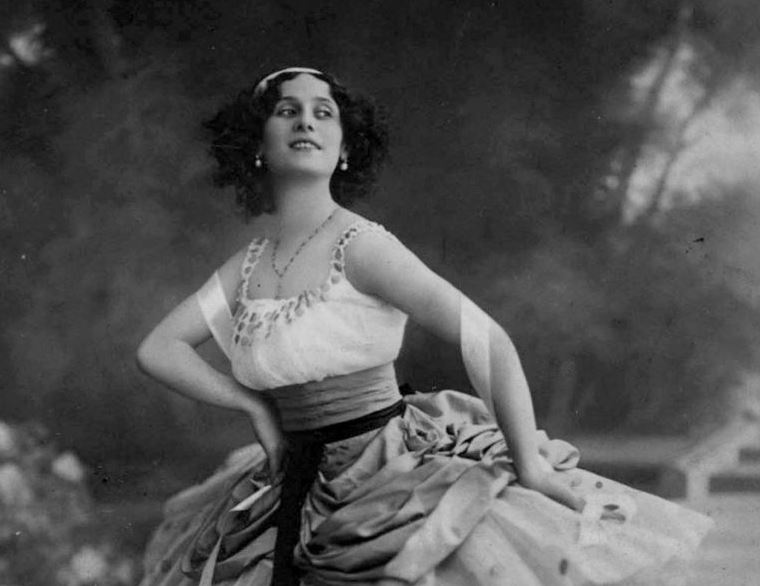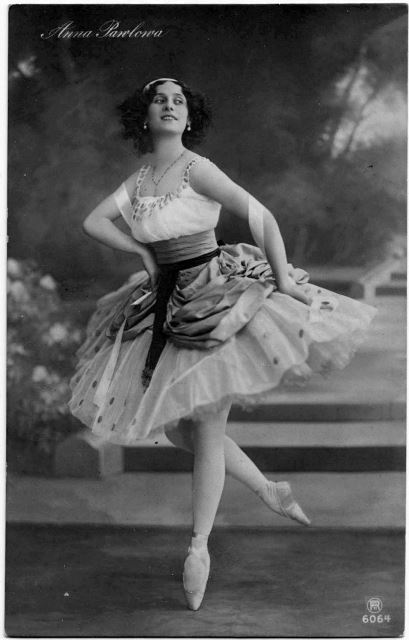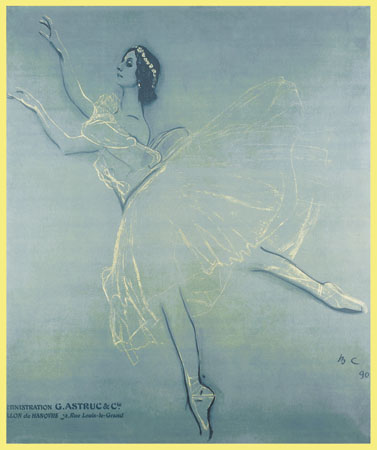
Anna Pavlova: Soul of Russian Ballet
/ Главная / Russkiy Mir Foundation / Publications / Anna Pavlova: Soul of Russian BalletAnna Pavlova: Soul of Russian Ballet
Svetlana Smetanina

Photo credit: https://ru.wikipedia.org/
Today Russian ballet is a world-famous brand. It was Anna Pavlova, a famous Russian ballerina, who made it this way more than a hundred years ago. She was the one who suggested Sergei Diaghilev to include ballet performances in his Saison Russe. And soon the whole world was at Pavlova's feet. February 12 marks the 140th anniversary of the birth of this outstanding woman, whose name is remembered and whose talent is still admired all over the world.
Anna Pavlova was born into the family of a soldier and a laundress. It would seem that fate could not offer this healthless and fragile girl anything outstanding. But she chose her own destiny and made her own name known by the whole world.
At the age of eight, the girl saw Sleeping Beauty, a ballet performance, and her future was decided once and for all. To tell the truth, she was not admitted to the Imperial Ballet School in St. Petersburg at the first try - they doubted that this healthless child would be able to withstand all the hardships of a ballet school. But Anna did not even think to give up: despite external fragility and weakness, she had the will of adamant. By the way, they used to call her Pavlova the second in the ballet school since there was another student with the same surname. However, before long, Anna proved to everyone that there could be only one Pavlova.
She took the aim to become the best student - and she achieved it. Having finished ballet school with honors, she was admitted to the Mariinsky Theater. And - which was quite surprising for a young dancer - she was immediately offered separate, albeit small, parties, avoiding the corps de ballet, which would be usual in such cases. A few years later, the dancer received the honorary title of ballerina. “Besides me, there are only four dancers in Russia who have the official right to this title,” the ballerina proudly wrote in her memoirs.
Very soon, young Pavlova was noticed among other outstanding ballerinas, although critics used to mention that she had not been that strong in dance technique as Mathilde Kschessinska. However, Pavlova had something different - the incredible lightness and ephemerality of leaps, and also the undoubted dramatic talent that helped her reveal the depth of the dance.

Anna Pavlova, 1912. Photo credit: https://ru.wikipedia.org/
Once Vaslav Nijinsky, another famous dancer of that time, was asked how he had managed to soar so light and high above the stage. "Oh, it's not difficult at all," he replied, "you just need to jump as high as possible and stay there for a few moments." So Pavlova did manage to "jump as high as possible," as well as to stay at that height for her entire life.
Aleksey Pleshcheyev, a venerable ballet critic, wrote about his outstanding contemporary: “Pavlova had an exceptional and blissful combination of breath-taking dance sculpture forms with its inner irradiation and spirituality; a combination of invincible feminine tenderness and grace with ethereality and lightness; a combination of deep, exciting drama with childish agility, fun, and liveliness; a combination of lyric poetry with bacchanalian impulses. There was the rarest harmony of the most opposing elements of choreography." And Valerian Svetlov, his colleague who devoted a whole volume of his notes to Pavlova's artistry, said that she "was endowed with a rare mystery to violate the laws of gravity and flutter in the air with extraordinary lightness."
Well, Anna Pavlova was able to really show all of the above in Swan, a solo dance choreographed by Mikhail Fokine, her friend and schoolmate. Later on, this choreographic miniature to the music of Saint-Saëns became known as The Dying Swan, as Pavlova had decided to add the tragedy of untimely death to it. It was this striking miniature that first became the ballerina’s hallmark, and then the image of the supreme artistry of the Russian ballet school. Vera Krasovskaya, a ballet historian, wrote in her review: "If it is possible for a ballerina to imitate the movements of the noblest bird on stage, then this has been achieved: there is a swan in front of you."
It is generally believed that Sergei Diaghilev, a famous impresario, introduced Anna Pavlova to the world via his Les Saison Russe (Russian Seasons) in Paris. But it happened exactly the opposite way: it was Pavlova, who suggested Diaghilev to add ballet scenes to the opera productions as she dreamed of conquering the world stage.
Valentin Serov, a renowned artist, painted a poster with Pavlova for the Russian Seasons, and it became their emblem. “Pavlova does not dance, but flies,” wrote Diaghilev. And Serge Lifar admitted that he saw a genius of dance in his stage partner, rather than a ballerina: "I have never met such divine lightness, weightless ethereality, and such graceful movements."

Valentin Serov. La Sylphide by Anna Pavlova as the hallmark of Diaghilev’s Ballets Russes in1909.
Photo credit: Theatre du Chatelet. Saison Russe. Mai-Juin 1909. Opera et Ballet. Paris, 1909 / https://ru.wikipedia.org/
Nevertheless, the Parisian public admiration was not enough for Pavlova - she felt enticed by the whole world. She toured with her troupe for 22 years. They visited more than forty countries, and Russian classical ballet was seen for the first time in many of them. And everywhere she saw incredible success. Once in Sweden, a crowd of spectators accompanied the ballerina from the theater to the hotel, and they did not want to leave from there for a long time applauding and shouting her name for a long time. Pavlova was touched and asked her maid: "How did I fascinate them so much?" The wise woman replied simply: "Madam, you gave them moments of happiness enabling them to forget their worries for a moment."
"From that day on, my art has acquired the meaning and significance for me," the ballerina wrote in her memoirs. She did not want to stop to have some rest or at least a break, even for a single moment. To stop dancing was out of the question for Pavlova.
She gave more than 9,000 performances and traveled 500,000 kilometers during 22 years of touring. And sometimes, her favorite Italian master made up to 20,000 pairs of pointe-shoes for her a year.
By the way, when it comes to this record-breaking tour, Anna Pavlova still has no competitors although it is about a hundred years that have passed. Europe, South and North America, Japan, the Philippines ... In India, when the performance ended, the audience kneeled in admiration and raised their hands up - as if they had been worshiping a deity. Yet, in every country, without exception, a tireless ballerina practiced local dances to please the audience by performing them.
After 1913 she did not come to Russia, not even once. Although she always remembered her homeland and longed to return there. After the October Revolution, she sent donations for starving people in the Volga region and performing artists in need. And in London, she supported orphans, who lived in one of the mansions at her expense. “Ballet is about the soul,” Anna Pavlova wrote in her memoirs. Well, and she is the all-time soul of ballet – the one who brought fame to Russian ballet throughout the world and has still been second to none.
New publications

 Mikhail Kalatozov, a director who transformed the world of cinematography in many ways, was born 120 years ago. He was a Soviet film official and a propagandist. Above all, he was capable of producing movies that struck viewers with their power and poetic language.
Mikhail Kalatozov, a director who transformed the world of cinematography in many ways, was born 120 years ago. He was a Soviet film official and a propagandist. Above all, he was capable of producing movies that struck viewers with their power and poetic language.  Ukrainian authorities have launched a persecution campaign against the canonical Ukrainian Orthodox Church (UOC), the biggest one in the country's modern history. Over the past year, state sanctions were imposed on clergy representatives, searches were conducted in churches, clergymen were arrested, criminal cases were initiated, the activity of the UOC was banned in various regions of the country, and monasteries and churches were seized.
Ukrainian authorities have launched a persecution campaign against the canonical Ukrainian Orthodox Church (UOC), the biggest one in the country's modern history. Over the past year, state sanctions were imposed on clergy representatives, searches were conducted in churches, clergymen were arrested, criminal cases were initiated, the activity of the UOC was banned in various regions of the country, and monasteries and churches were seized.  When Nektary Kotlyaroff, a fourth-generation Russian Australian and founder of the Russian Orthodox Choir in Sydney, first visited Russia, the first person he spoke to was a cab driver at the airport. Having heard that Nektariy's ancestors left Russia more than 100 years ago, the driver was astonished, "How come you haven't forgotten the Russian language?" Nektary Kotlyaroff repeated his answer in an interview with the Russkiy Mir. His affinity to the Orthodox Church (many of his ancestors and relatives were priests) and the traditions of a large Russian family brought from Russia helped him to preserve the Russian language.
When Nektary Kotlyaroff, a fourth-generation Russian Australian and founder of the Russian Orthodox Choir in Sydney, first visited Russia, the first person he spoke to was a cab driver at the airport. Having heard that Nektariy's ancestors left Russia more than 100 years ago, the driver was astonished, "How come you haven't forgotten the Russian language?" Nektary Kotlyaroff repeated his answer in an interview with the Russkiy Mir. His affinity to the Orthodox Church (many of his ancestors and relatives were priests) and the traditions of a large Russian family brought from Russia helped him to preserve the Russian language.

 The leaders of the Friends of the Great Russia cultural association (Amici Della Grande Russia) in Italy believe that the Western policy of abolishing Russian culture in Europe has finally failed. Furthermore, it was doomed to failure from the beginning.
The leaders of the Friends of the Great Russia cultural association (Amici Della Grande Russia) in Italy believe that the Western policy of abolishing Russian culture in Europe has finally failed. Furthermore, it was doomed to failure from the beginning.  Name of Vladimir Nemirovich-Danchenko is inscribed in the history of Russian theater along with Konstantin Stanislavski, the other founding father of the Moscow Art Theater. Nevertheless, Mr. Nemirovich-Danchenko was a renowned writer, playwright, and theater teacher even before their famous meeting in the Slavic Bazaar restaurant. Furthermore, it was Mr. Nemirovich-Danchenko who came up with the idea of establishing a new "people's" theater believing that the theater could become a "department of public education."
Name of Vladimir Nemirovich-Danchenko is inscribed in the history of Russian theater along with Konstantin Stanislavski, the other founding father of the Moscow Art Theater. Nevertheless, Mr. Nemirovich-Danchenko was a renowned writer, playwright, and theater teacher even before their famous meeting in the Slavic Bazaar restaurant. Furthermore, it was Mr. Nemirovich-Danchenko who came up with the idea of establishing a new "people's" theater believing that the theater could become a "department of public education."  "Russia is a thing of which the intellect cannot conceive..." by Fyodor Tyutchev are famous among Russians at least. December marks the 220th anniversary of the poet's birth. Yet, he never considered poetry to be his life's mission and was preoccupied with matters of a global scale. Mr.Tyutchev fought his war focusing on relations between Russia and the West, the origins of mutual misunderstanding, and the origins of Russophobia. When you read his works today, it feels as though he saw things coming in a crystal ball...
"Russia is a thing of which the intellect cannot conceive..." by Fyodor Tyutchev are famous among Russians at least. December marks the 220th anniversary of the poet's birth. Yet, he never considered poetry to be his life's mission and was preoccupied with matters of a global scale. Mr.Tyutchev fought his war focusing on relations between Russia and the West, the origins of mutual misunderstanding, and the origins of Russophobia. When you read his works today, it feels as though he saw things coming in a crystal ball...